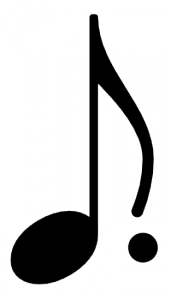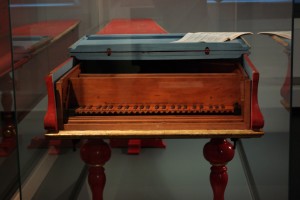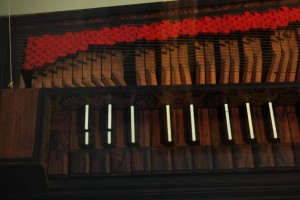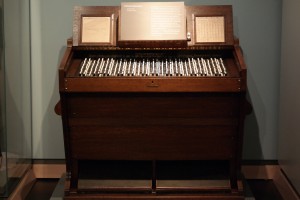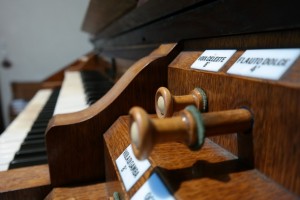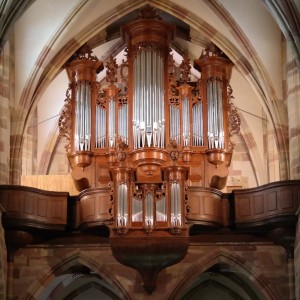
Im Gegensatz zur deutschen Orgelmusik lässt sich in den klassischen französischen »Livre d’orgue« verschiedener Komponisten oft direkt am Titel des Stückes die Registrierung ablesen. Allerdings muss man diese dann auf das jeweilige Instrument übertragen. Da die Registrieranweisungen einen reichen Fundus an Klangfarben voraussetzt, wird man an kleineren Instrumenten Kompromisse eingehen müssen.
Im Buch »Zur Interpretation der französischen Orgelmusik« hat sich Hans Musch die Mühe gemacht, in tabellarischer Form die Registrieranweisungen verschiedener Komponisten nebeneinanderzustellen. Spielt man öfter, lohnt es sich, sie in Setzerspeichern oder über eine Software abrufbar zu machen. Für manuelle Registrierungen hier eine komprimierte Darstellung oben genannter Tabellen.
Plein Jeu
Ein solchermaßen bezeichnetes Stück eröffnet üblicherweise die Liturgie. Es stellt die Prinzipalchöre ohne Aliquten dar. Gelegentlich werden die 16′ und 8′-Prinzipale durch offene 16′ und 8′-Flöten gedoppelt.
Die Passagen auf dem Hauptwerk sind in den Noten gerne mit »Grand Plein Jeu«, die auf dem Positiv mit »Petit Plein Jeu« vermerkt. In seiner »Suite du Deuxième Ton« aus dem »Premier Livre d’Orgue« von Louis-Nicolas Clérambault aus dem Jahre 1710 sind zusätzlich Geschwindigkeitsangaben zu finden: Das Hauptwerk “Lentement” (langsam), das Positiv “Gay” (gaiement, munter, fröhlich).
Registrierungsbeispiel:
Grand Orgue:
Montre 16′
Bourdon 16′
Montre 8′
Bourdon 8′
Prestant 4′
Doublette 2′
Fourniture
Cymbale
Positif:
Montre 8′
Bourdon 8′
Prestant 4′
Doublette 2′
Fourniture
Cymbale
Manualkoppel
Plain Chant
In dieser Variante kommt im Pedal die Trompete 8′ und das Clairon 4′ hinzu, um die Choralmelodie zu spielen.
Fond d’Orgue
Hierbei handelt es sich um eine Zusammenstellung der Grundstimmen.
Grand Orgue:
Bourdon 16′
Montre 8′
Bourdon 8′
Prestant 4′
Positif:
Bourdon 8′
Prestant 4′ oder
Montre 8′
Manualkoppel
Duo
Ein lebhaft gespieltes zweistimmiges Stück. So man denn hat, kommt auch das dritte Manual mit einem Cornet zum Einsatz. Die Registrieranweisungen sind unterschiedlich. Generell lassen sich Registrierungen ohne und mit LIngualen unterscheiden.
Duo rein labial:
Grand Orgue:
Bourdon 16′
Bourdon 8′
Prestant 4′
Tierce 3 1/5′
Nazard 2 ?’
Tierce 1 3/5′
Positif:
Bourdon 8′
Prestant 4′
Nazard 2 ?’
Tierce 1 3/5′
Récit:
Cornet 5-fach
Duo mit Lingualstimmen:
Grand Orgue:
Trompette 8′
Bourdon 8′ (optional)
Prestant 4′ (optional)
Positif:
Bourdon 8′
Prestant 4′
Nazard 2 ?’
Tierce 1 3/5′
Cromorne ou Trompette 8′
Récit:
Cornet 5-fach
Trio (à deux dessous)
Zwei Stimmen in der rechten Hand, eine Stimme in der linken Hand, getragene Ausführung.
Grand Orgue:
Bourdon 8′
Prestant 4′
Nazard 2 ?’
Quarte de Nazard 2′
Tierce 1 3/5′
Tremblant doux
Positif:
Bourdon 8′
Prestant 4′
Cromorne 8′
Basse de Cromorne
Lebhaft gespielt.
Grand Orgue:
Bourdon 8′
Prestant 4′
Positif:
Bourdon 8′ (optional)
Prestant 4′
Nazard 2 ?’ (optional)
Tierce 1 3/5′ (optional)
Cromorne 8′
Basse (et dessous) de Trompette
Hier wird in der linken Hand versucht, tatsächlich eine Trompete nachzuahmen.
Grand Orgue:
Bourdon 8′
Prestant 4′
Trompette 8′
Positif:
Bourdon 8′
Prestant 4′
Larigot 1 1/3′ (optional)
Voix Humaine
Für ein Diskantsolo (Dessous):
Bourdon 8′
Flûte 4′
Voix Humaine 8′
Prestant 4′ (optional, wird gern für ein Bass-Solo hinzugenommen)
Tremblant Doux (“nur wenn er was taugt” lese ich aus dem Absatz heraus).
Die Begleitung auf dem anderen Manualwerk erfolgt als »Jeu doux«. Das sind zarte Grundstimmen, wie
Bourdon 8′
Montre 8′
oder
Bourdon 8′
Flûte 4′
oder
Bourdon 8′
Prestant 4′
Récit als Diskantsolo
Ein Recit kann man sich durchaus als eine Art “Erzählung” von der Bühne herunter vorstellen. Somit finden sich auch Stück wie »Récit de Voix humaine« oder »Récit de Cromorne«. Passend dazu finden sich in manchen Instrumenten eigene Diskantwerke mit eigenem Manual, die mit Récit bezeichnet und mit entsprechenden Registern bestückt sind.
Die Stücke sind oft nicht explizit als »Récit de …« benannt. Bezeichnungen sind »Dessous de Trompette« (statt »Récit de Trompette«) oder »Cornet« (statt »Récit de Cornet«).
Récit als Tenorsolo
Hier ein Beispiel für ein »Récit de Cromorne en taille«:
Grand Orgue:
Bourdon 8′
Montre 8′ oder
Prestant 4′
oder beide.
Positif:
Bourdon 8′
Prestant 4′
Cromorne 8′
Pedalle
Oft nur als »Pedalle de Flûte« aufgeführt. Dom Bedos wird präziser:
Flûte 16′
Flûte 8′
Flûte 4′
Tierce en taille
Grand Orgue:
Bourdon 16′ (optional)
Montre 8′ oder
Bourdon 8′ (oder auch beide)
Prestant 4′
Positif:
Montre 8′ (optional)
Bourdon 8′
Prestant 4′ oder
Flûte 4′
Nazard 2 2/3′
Doublette 2′
Tierce 1 3/5′
Larigot 1 1/3′
Pedalle
Pedalle de Flûte
Concert de Flûtes
Es geht darum, den Klang einer Querflöte zu imitieren. Zum Einsatz kommen beispielsweise Acht- und möglicherweise 4′-Flöten. Alternativ kann man auch 8′-Flöten verwenden eine Oktave höher spielen als notiert.
Grand Orgue:
Bourdon 8′
Flûte 4′
Tremblant doux
Positif:
Bourdon 8′
Flûte 4′
Tremblant doux
Manualkoppel
Dialogue sur les Grands Jeux
Hier kommen die Lingualregister zur Geltung, beispielsweise:
Grand Orgue:
Bourdon 8′
Prestant 4′
Nazard 2 ?’
Cornet 5-fach
Trompette 8′
Clairon 4′
Tremblant à vent perdu
Positif:
Bourdon 8′
Prestant 4′
Nazard 2 ?’
Tierce 1 3’5′
Cromorne 8′
Manualkoppel

